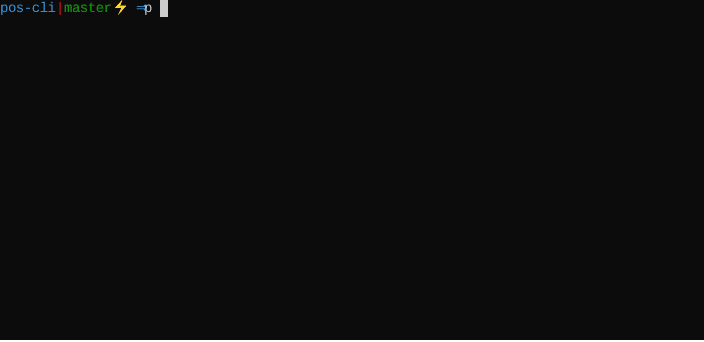Recording Your Terminal to SVG

Paweł Kowalski
Posted on March 27, 2020

Problem
This use case describes how we recorded the pos-cli introduction and saved it as an SVG to embed it on our marketing website.
There are a couple of ways for recording your screen to share it on the Internet.
- Animated GIF - Pretty easy to do with tools like Kap, but it has heavy drawbacks. Maximum of 256 colors, balance between FPS and file size is very delicate, and gif files are usually big.
- Video (mp4, webm) - Pretty easy with tools like Kap, but needs usage of the video tag, which is not always a possibility (markdown readme being a big one).
- Animated PNG - We have never seen anyone use it, even though the browser support is there. This is a good candidate to experiment.
- Finally, SVG — All of the above solutions can record everything, the whole screen with images, so they are more universal. What we need is to record only terminal, which is predominantly text. This means, recordings will be much smaller than the closest alternative - gif, and easier to embed in more places than videos.
So, which solution did we choose for showing the recording of our CLI as an image on our website?
Solution
If you only need to share your terminal recording with someone, without embedding it on a website, we recommend the excellent asciinema.
But if you want to show off your recording as an image on your website, then you need an image format that is natively understood by browsers.
Enter: termtosvg
Instead of talking about what it does, let's look at some examples.
Apart from recording what you see in your terminal, you can also change the theme, just in case your terminal is heavily customized and you want a simpler look and feel.
Installation
It is a Python 3 script, so you will need to have Python in your system.
pip3 install termtosvg
Usage
When you use termtosvg, it starts recording immediately.
pos-cli|master ⇒ termtosvg helloworld.svg
Recording started, enter "exit" command or Control-D to end
It is time do what you want to record.
pos-cli|master ⇒ echo "Hello world"
Hello world
When you are ready to end and save your recording, press Control-D.
pos-cli|master ⇒
Rendering ended, SVG animation is hello.svg
You can even nest recordings, so I recorded all those commands above into an SVG file:
More options
If you need to do more complicated things, type termtosvg -h which will give you information about the options it provides.
pos-cli|master ⇒ termtosvg -h
usage: termtosvg [output_path] [-c COMMAND] [-D DELAY] [-g GEOMETRY]
[-m MIN_DURATION] [-M MAX_DURATION] [-s] [-t TEMPLATE] [-h]
Record a terminal session and render an SVG animation on the fly
positional arguments:
output_path optional filename of the SVG animation. If --still-
frame is specified, output_path should be the path of
the directory where still frames will be stored. If
missing, a random path will be automatically
generated.
optional arguments:
-h, --help show this help message and exit
-c COMMAND, --command COMMAND
specify the program to record with optional arguments
(default: /bin/zsh)
-D DELAY, --loop-delay DELAY
duration in milliseconds of the pause between two
consecutive loops of the animation (default: 1000ms)
-g GEOMETRY, --screen-geometry GEOMETRY
geometry of the terminal screen used for rendering the
animation. The geometry must be given as the number of
columns and the number of rows on the screen separated
by the character "x". For example "82x19" for an 82
columns by 19 rows screen.
-m MIN_DURATION, --min-frame-duration MIN_DURATION
minimum duration of a frame in milliseconds (default:
1ms)
-M MAX_DURATION, --max-frame-duration MAX_DURATION
maximum duration of a frame in milliseconds (default:
No maximum value)
-s, --still-frames output still frames instead of an animation.
-t TEMPLATE, --template TEMPLATE
set the SVG template used for rendering the SVG
animation. TEMPLATE may either be one of the default
templates (base16_default_dark, dracula, gjm8_play,
gjm8_single_loop, gjm8, powershell, progress_bar,
putty, solarized_dark, solarized_light, terminal_app,
ubuntu, window_frame_js, window_frame_powershell,
window_frame, xterm) or a path to a valid template.
See also 'termtosvg record --help' and 'termtosvg render --help'
Results
Having the SVG ready, you can embed it anywhere you want, using your favorite image syntax.
(Click to open in new tab)
This post was inspired by this dev.to post by Bruno Paz, where he showed how to use asciinema and a converter to achieve a similar result. You might also use that approach in your development workflow: Record and share an asciinema recording to get feedback from your team, and when it is good enough, convert it to SVG and ship.

Posted on March 27, 2020
Join Our Newsletter. No Spam, Only the good stuff.
Sign up to receive the latest update from our blog.

